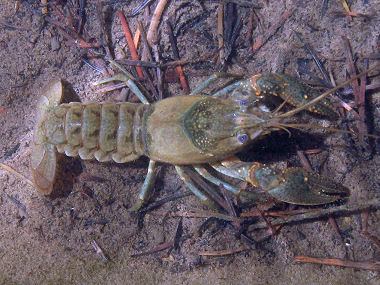| Crayfish, also known as crawdads,
crawfish, spiny lobsters, or aquatic cockroaches, are
found in many lakes and streams in Arizona. They look like little
lobsters, growing to about 3 inches in length. They have a joined head
and thorax and a segmented body which is typically brown or greenish in
color.
|
The head has two pairs of sensory
antennae and a pair of eyes on movable stalks. The appendages of the thorax include four pairs
of walking legs and one pair of claw bearing arms, which it extends in front of its body while
moving. These strong pinchers are specialized for cutting, capturing
food, attack, and defense. Crayfish have a hard outside skeleton which
provides protection and allows movement, but limits growth. As a result,
the crayfish regularly gets too big for its skeleton, sheds it, and
grows a new larger one. This is called molting and occurs six to ten
times during the first year of rapid growth, but less often during the
second year. For a few days following each molt, crayfish have soft
exoskeletons and are more vulnerable to predators.

|
Arizona is the only state with no
native crayfish species, they were introduced by government
agencies to control weeds and to feed bass and fishermen as bait.
Unfortunately they have thrived and their presence has decimated
aquatic plants and animals throughout the state. The AZ Department
of Game and Fish has a
brochure with additional information as well as tips for
catching and cooking crayfish. |
Crayfish prefer permanent, well-oxygenated ponds,
lakes, rivers and streams with substrates of silt or rocks. They can
live in water as shallow as a few inches to as deep as 100 feet and will
tolerate water temperatures ranging from 33.8-89.6 F.
Crayfish are opportunistic feeders, eating both plants
and animals, and can quickly outgrow predation by most fishes. They eat
just about anything they can put their claws around, including aquatic
plants, larval fish, snakes, turtles, insects and other
invertebrates.Since Arizona has few natural agents to control them,
crayfish populations have exploded. They have been implicated in a
number of native species declines in Arizona, including leopard frogs,
mud turtles, and endangered fish species such as the Little Colorado
spinedace. |

